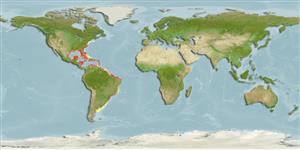Echinoidea |
Camarodonta |
Toxopneustidae
Environment: milieu / climate zone / depth range / distribution range
Ecology
Benthic; brackish; depth range 0 - 50 m (Ref. 83942). Tropical; 37°N - 33°S, 99°W - 28°W
Western Central Atlantic: from USA to Brazil, throughout the Caribbean.
Length at first maturity / Size / Weight / Age
Maturity: Lm ? range ? - ? cm Max length : 11.0 cm TL male/unsexed; (Ref. 415)
This an epibenthic, subtidal species found in seagrass (Ref. 83942), particularly Thalassia sp. beds and lagoonal mangrove cays (Ref. 86574).
Life cycle and mating behavior
Maturity | Reproduction | Spawning | Eggs | Fecundity | Larvae
Members of the class Echinoidea are gonochoric. Fertilization is external. Brooding is common, eggs are held either on the peristome, around the periproct or deep into the concavities on the petaloids. Life cycle: Embryos develop into planktotrophic larvae (echinoplateus) and live for several months before they sink to the bottom using their tube feet to adhere on the ground where they metamorphose into young urchins.
Collin, R., M.C. Díaz, J. Norenburg, R.M. Rocha, J.A. Sánchez, M. Schulze, A. Schwartz and A. Valdés 2005 Photographic identification guide to some common marine invertebrates of Bocas Del Toro, Panama. Caribbean Journal of Science. 41(3):638-707. (Ref. 415)
IUCN Red List Status
(Ref. 130435: Version 2025-1)
CITES status (Ref. 108899)
Not Evaluated
Not Evaluated
Threat to humans
Human uses
| FishSource |
Tools
More information
Population dynamicsGrowthMax. ages / sizesLength-weight rel.Length-length rel.Length-frequenciesMass conversionAbundance PhysiologyOxygen consumption
Human RelatedStamps, coins, misc.
Internet sources
Estimates based on models
Preferred temperature
(Ref.
115969): 22.8 - 28, mean 26.1 (based on 306 cells).
Fishing Vulnerability
Low vulnerability (10 of 100).
Price category
Unknown.
